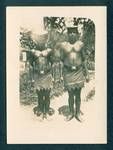Connect with Grigore Antipa National Museum of Natural History
Contact this content partner to get more information about this item.
["Oeneis (Oeneis) melissa lucilla Barnes and McDunnough, 1918 - mascul"]
- Description:
- on the rewritten collection label, the altitude is wrong (14200 ft. instead of 14260 ft.); at the needle there is the original collection label of Robert (Bob) Pyle and the determination label of Aurelian Popescu-Gorj Oeneis melissa is a holarctic species spread in northern Siberia and North America, from Alaska to Labrador and Baffin Island; isolated populations are still found in the highlands of Japan, in the Rocky Mountains. It is a species found in the tundra areas or in the rocks of the alpine area near the glaciers. The biological cycle extends over two years (in the first year it hibernates the first larval stage, while in the second year it hibernates the last larval stage). Robert Michael Pyle (born July 19, 1947 in Denver, Colorado) was one of the most active North American lepidopterologists in the second half of the twentieth century. After graduating from college, in 1965, Pyle focused all his efforts to train in the field of nature protection, with a special emphasis on the conservation of invertebrates. He obtained B.S. Degree at the University of Washington (Seattle), M.S. at UW College of Forest Resources and obtained a Fulbright scholarship that gave him the opportunity to study the conservation of diurnal butterflies at Monks Wood Experimental Station from Abbot 's Ripton, UK, one of his mentors being a famous English biologist, John Heath. In 1976 he obtained Ph.D. At the Yale School of Forestry & Environmental Studies with a work about the eco-geography of conservation of lepidoptera. Pyle worked as a field naturalist for Sequoia National Park, consultant for the Wildlife Division of Papua New Guinea and was co-manager of Species Conservation Monitoring Centre in Cambridge, UK, where he worked on the writing of the first edition of the IUCN Invertebrate Red Data Book. Inspired by what has been learned, Pyle decides to establish, in 1971, the famous Xerces Society for Invertebrate Conservation, dedicated to preserving endangered invertebrates. Since 1975, Pyle has been actively involved in preserving the famous monarch butterfly, organizing the First International Conference for the conservation of the monarch butterfly (Morelos, Mexico) and actively leading The Monarch Project within the Xerces Society. Robert Michael Pyle is also currently considered an emblematic figure for contemporary North American lepidopterology.
- Format:
- image
- Collections:
- Grigore Antipa National Museum of Natural History
- Content partner:
- Grigore Antipa National Museum of Natural History
- Availability:
- Not specified
-
Copyright status: Share, modifyFind out more about what you are able to do with this itemMore informationGrigore Antipa National Museum of Natural History has this to say about the rights status of this item:
http://creativecommons.org/licenses/by-sa/4.0/
What can I do with this item?Non-infringing useNZ copyright law does not prevent every use of a copyright work, and this item may be hosted by an international institute or organisation. You should consider what you can and cannot do with a copyright work.Share itThis item is suitable for copying and sharing with others, without further permission.Modify itThis item is suitable for modifying, remixing and building upon, without further permission.Check about commercial useYou'll need to confirm with the copyright holder using this item for commercial purposes.
Related items
Welcome and warm Pasifik greetings
The information on this site has been gathered from our content partners.
The names, terms, and labels that we present on the site may contain images or voices of deceased persons and may also reflect the bias, norms, and perspective of the period of time in which they were created. We accept that these may not be appropriate today.
If you have any concerns or questions about an item, please contact us.
